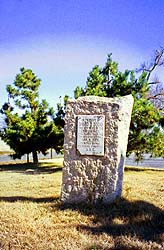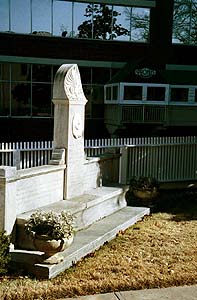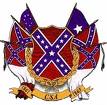Instead of listing my sources at the bottom, I'm putting my bibliography here at the head of the article because it consists of one book only. The book is Boy Hero of the Confederacy: The Life, Legend and Execution of David Owen Dodd by Jim Lair, Oak Hill Publishing Company, Springfield, MO. 2001. Everything else I found on Dodd was also in this book. It's got everything on Dodd from transcripts of the trial right down to the biographies of the members of the court that tried him. It's the most complete compilation of Dodd research I've come across -- one-stop shopping for David O. Dodd history.
"BOY HERO OF THE CONFEDERACY"
David O. Dodd
Of all the war heroes in Arkansas' history, this is the one with the most monuments in the state -- more even than Douglas MacArthur. The short version of his story goes like this. During the Civil War, 17-year-old Dodd, in southern territory, went to Federally occupied Little Rock on a business errand for his dad. On his way back to South Arkansas, troops at a Federal checkpoint found a notebook in his shoe which contained in morse code in Dodd's own handwriting, a thorough, detailed and perfectly accurate list of all the Union forces in Little Rock.
Ten days later he was hanged as a spy. The heroic part is that he never divulged the source of his information or the name of his spymaster. He was hanged in front of the college he had briefly attended and was buried in a borrowed grave.

Here's a picture of that borrowed grave and of twenty-one guns going off in his honor at the annual observance of his execution. That eight-foot-tall obelisk to the left of the center of the photograph is his tombstone. There's nothing on the stone to mark Dodd's status as a folk hero. It's just name, place of birth (Lavaca County, Texas), and dates of birth and death. The giant obelisk was put here in 1911 at a cost to the state of $3000. It also contains a grammatical error. "Here lies the remains...."

Also in 1911, this stained glass window was built and sent to the old Confederate White House in Richmond, VA, which was was being converted into a museum devoting one room to each of the eleven confederate states. The window was built in New York and depicts Dodd as Southern saint and martyr and somehow a curly-haired blonde, even though his only known photograph shows him with straight black hair. I guess that's part and parcel of being immortalized in stained glass. No matter your appearance in real life, you end up a curly headed blonde looking pleasantly oversedated like a local meteorologist. And check out the posture. He looks weak as a willow, and note the angle of the wrists. This isn't the real Dodd. By all reports he was something of a ladies man. This isn't the actual window, but a replica that you can see at the MacArthur Museum of Arkansas Military History. All this Dodd mania was probably associated with the last big reunion of the United Confederate Veterans, held in Little Rock in 1911. Two or three thousand aging veterens were expected to attend. Over a hundred thousand visitors showed up.

The Only Known Photograph of David O. Dodd
Dodd's family was upper middle merchant class on both sides, and his father, Andrew, was about the least successful member of the family. Nevertheless, he was always in there plugging, buying and selling and moving from one opportunity to the next. The Dodd family was residing in Little Rock when the war broke out. David himself was a cadet at St. John's Masonic College, just over a hundred yards from the Little Rock Arsenal. David and his father were in Mississippi in September of 1863 when Little Rock was taken by the Federals. Father sent Son to fetch Mother and Sisters away from Little Rock to the safety of the South. Mom and sisters got on a riverboat, but the boat was jammed with Yankee troops, and the ladies found this so unpleasant that they got off the boat and refused the ride. Some sources said the soldiers were abusive, others contend the ladies were just virulently anti-Yankee. Dad had to come to Little Rock to fetch the ladies away himself.
While waiting for Dad, David took jobs clerking in stores that sold goods to the Yankee troops. That created a minor irony in that David was serving as a suttler to northern troops while his father was a suttler to southern troops. Around December 1st, Andrew arrived, packed up his family in a wagon and took them south to Camden.
Andrew hatched a plan to buy tobacco, which was becoming ever rarer as northern troops destroyed southern fields, and store it for sale as its rarity increased. He needed cash for his enterprise. The more you buy, the better price you get and so the more profit you make upon retail sale. But the war had put a border inconveniently in between himself in Camden and his closest business associates in Little Rock.

David O. Dodd Elementary School. Red Circle shows location of monument.
He decided to send David, a minor and therefore assumed neutral, back to Little Rock to deliver business correspondence to former associates soliciting investments in Andrew's big tobacco deal. They went to a Confederate General named Fagan to get passes that would allow David to pass confederate pickets. At the conclusion of the meeting, Fagan said jokingly something like, "Of course, I'll expect a full report upon your return." Either David did not understand this as a joke, or he decided on his own to undertake the gathering of intelligence. Of course, General Fagan might have been joking-but-not-joking, planting the notion in the boy's head while absolving himself of blame for placing a noncombattant in grave danger.
On Christmas Eve, David reentered Little Rock. He delivered his letters and enjoyed the holiday season attending parties and dances and keeping company with a girl of sixteen named Mary Dodge. This little girl was an ardent supporter of the Southern cause, while her dad, R. L. Dodge was a Vermont native on friendly terms with the northern troops. Northern officers were quartered in the Dodge home. It is suggested that Mary Dodge is the source of the information that David carried in his notebook, and that she obtained the information from the officers. Various historians and epic poets have tried to make Mary and David into sweethearts for literary purposes. While that's possible, David attended dances that holiday season with at least two other girls we know by name (Mary Swindle and Minerva Cogburn).
December 29, David left Little Rock riding on a mule and carrying a Federal pass that he'd obtained from the provost marshall at St. John's Masonic College. As he left Union territory, the guard tore up the pass, telling David that since he was now in confederate held land, he wouldn't need the pass any more. Instead of heading toward Benton at that point, he detoured toward Hot Springs to spend the night at an uncle's house.
The next day David backtracked and took a cross road to get back on the Benton road. Apparently that cross road crossed back into Union territory, because David ran into Federal pickets. Today that spot is the site of David O. Dodd Elementary School, and the fateful track connecting the Hot Springs Road to the Benton Road is approximated by David O. Dodd Street. The pickets found David's behavior suspicious. He didn't have a pass and they arrested him. There's a marker near the front door of the school declaring this to be the approximate location of the arrest.


Text of monument reads, "DAVID OWEN DODD -- Arkansas' boy hero of the War Between the States was captured at this place Dec. 31, 1863. and executed in Little Rock, Jan. 8. 1864. -- 'He died to save. We live to serve.' -- Erected by David O. Dodd Chapter UDC Pine Bluff, Ark." David was taken to regimental headquarters, which was this place, known as "Ten Mile House" because it's ten miles from downtown Little Rock on the old Stagecoach Road to Benton. I visited the building behind the house which served as Dodd's cell that night, but the owner preferred that I not post a photo of it. Ten Mile House is billed as the oldest brick building in Arkansas (built circa 1820), and not so very long ago it was a restaurant. It changed hands in 2000 and I don't know what the new owner is doing with it.

David was questioned a couple of times that evening by the senior officers at the post. He had not been searched by the arresting soldiers; and when he finally was, that's when the notebook with the ciphered information was discovered.
The next day, David was taken to Little Rock to face Brigadier General Davidson, who was commanding the Union occupation forces in General Steele's absence. A telegraph operator translated the morse code to discover the full extent of the information held in the notebook. David was then formally charged as a spy and was hustled off to the military prison, which was on the site of the present state capitol building.
Dodd was tried by a military tribunal of six Union officers. His defenders, assigned by the court, didn't put up much of a fight. They first played some word games with the definition of spying. The law said that a spy was someone who, among other things, "lurked" and concealed himself or assumed a false identity in order to gather information. Since Dodd had not done any of these things, they argued that technically he was not a spy.
The court didn't buy the argument. He was caught red-handed attempting to enter confederate territory carrying a coded message written in his own handwriting detailing all the military units under General Steele's command. Dude was so busted!
Concerning what was going on behind the scenes during the trial there is much conjecture based on few facts. General Steele was in no hurry to hang a seventeen-year-old kid in his own home town. That's like asking for a riot. Rumors were flying that General Fagan was mounting a rescue attempt.
For two days, David was interrogated by Union officers who were eager to discover the source of the information that Dodd had obtained.
On the third day, under personal orders from General Steele, Mary Dodge and her father were escorted under armed guard to a Union gunboat on the Arkansas. They were transported to Vermont, where Mary was kept until the end of the war. This event strongly suggests that General Steele had discovered that Mary Dodge was involved; and if he blanched at hanging a boy of seventeen, he certainly couldn't bring himself to hang a girl of sixteen.
Some say that David claimed General Fagan had made intelligence gathering a condition for obtaining the pass to Little Rock. Fagan is sometimes painted as the villain of the story, but there's no corroboration of any version of his involvement.
The official version is that Dodd never implicated anybody, but there is the matter of Mary Dodge's abrupt departure to the far far north. General Steele could have discovered her involvement in other ways, however. David was daily visiting her at her house where Union officers were billetted. Once David was caught, there's no way she would not be suspected. The officers living in the house would be interrogated and would soon realize that they had said quite a lot in front of this little girl.
I find myself sympathizing with General Steele at this point in the story. He's in a hell of a fix. His superiors frequently criticize him for being too friendly with the Southerners under his occupation, too easygoing and accommodating. Suddenly he discovers a nest of spies, and they're kids. It's a situation where he can't make a good decision. If he cracks down he looks brutal and he loses the goodwill of the populace. If he doesn't hang somebody for this most serious of offense, he's likely to lose his command. He found himself assuming the role of Pontius Pilate.
And like Pilate, he washed his hands. The ladies of the aristocratic classes of Little Rock appealed to General Steele for clemency. Steele said he had no authority to pardon Dodd or commute the sentence passed by the tribunal.
On the sixth and final day of the trial, the defense played its last desperate card. Dodd read a long prepared elocution begging for an exception on account of his youth and stating that the information in his notebook amounted to incidental notations like those a man might keep in a diary. The tribunal voted four-to-two to hang him.
In the corner of the parking lot of the University of Arkansas School of Law in Little Rock you can find the monument below, which marks the spot where David O. Dodd was hanged.

Monument at the site of Dodd's execution.
There was ice on the ground the morning of January 8th. Dodd's execution was a dark gothic spectacle. David put on the suit in which he was to be buried. He rode in an open wagon under close guard out of the gates of the military prison, straddling his own coffin, passing not far from his own grave in Mount Holly Cemetery. The wagon halted in front of St. John's Masonic College, where David had been a cadet just a couple of years earlier. Witnesses reported that he was a bit drawn and pale, but calm and resolute, practically indifferent. It was occasional in those days for a friend or family member to try to slip the condemned a dose of opium to ease his way to the gallows. There's no suggestion that this was done here, but it was sometimes done in cases like this.
As if the proceedings weren't macabre enough, the name of the executioner was Dekay.
The tailgate of the wagon was propped horizontal. David stood on it under a yoke which had been built for the occasion. The hangman took David's coat. The hangman noticed he had forgotton to bring a blindfold. David mentioned that there was a handkerchief in his coat. The blindfold was fastened. David's hands and feet were tied. Several of the soldiers in attendance turned their backs on the execution in silent protest of the hanging of a boy.
There are several versions as to what his last words were. Nathan Hale stuff mostly. Most of them agree in principal, if not in substance and length. I don't think any of them can be taken any more seriously than the others. This was an era in which last words were thought to be of great significance. People prepared last words in anticipation of their deaths and people embellished last words after the fact for the sake of the heroic ideal. Chances are that one of his reported last words is pretty close to factual, but I couldn't begin to guess which one.
The rope was fixed around David's neck, the prop knocked from under the tailgate.
The rope was either just a bit too long or just a bit too new and stretchy. David was slightly built, not heavy enough to generate a neck-snapping jolt falling from the low height of a wagon's tailgate. David's tiptoes touched the ground, and rather than having his neck snapped, he began slowly to strangle and twist and flail. One source says a soldier fainted at this point and several witnesses became nauseous.
There are two versions of what happened next.
Version one holds that one or two soldiers grabbed his legs to add weight and hasten his death. Version two holds that a soldier shinnied up the gibbet to grab the noose, twist the rope and raise the condemned off the ground. That shows how hard it is to get a grip on history sometimes. Here's something witnessed by a hundred or so people and there's not enough corroboration to pin down a detail like this.

Another Dodd monument, this one on the grounds of the Old State House David's body was taken down. A doctor pronounced him dead.
His body was kept under armed guard overnight in the home of Mrs. Barney Knighton on Rock Street. Somebody stole the rope. Family members surmised that officials had it destroyed to prevent it from becoming a southern patriotic relic.
Just before the funeral, a Federal officer arrived to convey orders from Federal HQ that no words were to be spoken or sung at the memorial service, and only Dodd's two aunts and their husbands (his closest relatives in northern held territory) would be allowed to attend the burial. The whole town was on alert. The place was a tinderbox. There was dissent in the Federal ranks over the execution. A riot was a real possibiltiy. Some feared that a Confederate force might take advantage of the situation to stage a raid. The guard was increased around General Steele's HQ, and nobody was allowed to see him except on official business.
Little Rock held its collective breath and nothing much happened. Dodd's body was buried in Mount Holly Cemetery, also the eventual resting place of R.L. Dodge and General Fagan.
News of the execution of their son absolutely wrecked Andrew and Lydia Dodd. That's not an unusual thing for the Civil War, or any war for that matter. They both spent the rest of their lives distraught and in ill health, Andrew dying of yellow fever just two years after the war and Lydia dying in Pascagoula in 1885. Other bad things happened related to the incident. In March, the kind-hearted General Steele was relieved of responsibilities in Little Rock (to lead the overland forces in the ill-fated Red River campaign) and was replaced by a harsh anti-southern commander. General Fagan was for the rest of his life vilified as the man who coerced David into spying, whether he actually was or not.
At least seven poets have attempted the material, usually adding whatever embellishments deemed necessary to make this tragic pileup into an heroic epic saga. Adding to the problem of reassembling the facts are the facts that 1) during reconstruction, folks in the south were reluctant to recount stories of southern heroism and 2) many who did recount the story had an agenda other than historical accuracy. Hollywood even took a shot at the story in 1915. No print remains.
In the end he didn't so much die for the southern cause but to protect his accomplice, who must have spent that first week of January sweating bullets.
RTJ -- 8/1/02
--------------------------------------------------------------------------------
Arkansas Travelogue home page


No comments:
Post a Comment
Note: Only a member of this blog may post a comment.